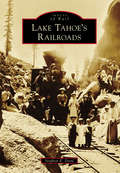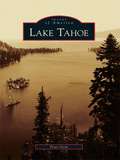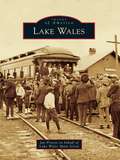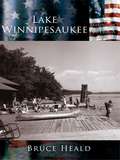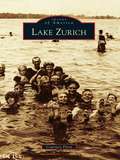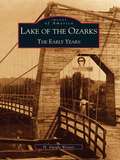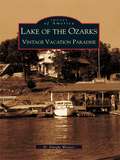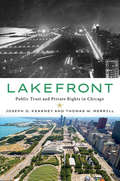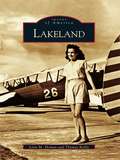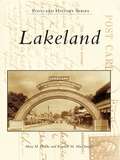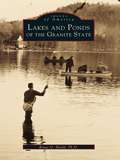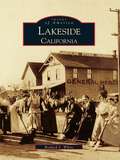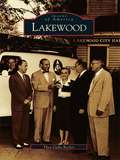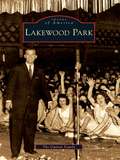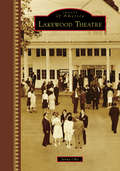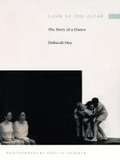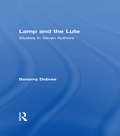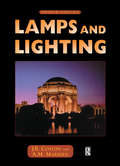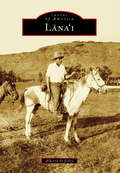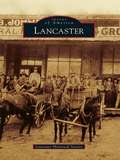- Table View
- List View
Lake Tahoe's Railroads (Images of Rail)
by Stephen E. DrewLake Tahoe is the majestic mountain lake that spans the boundary line of California and Nevada. The lake’s clarity and scenic beauty are legendary. In the 1870s, the Nevada Comstock Lode created an insatiable appetite for Lake Tahoe’s virgin pine forests. The timbers would shore up underground mining and build communities approaching 40,000 inhabitants. Railroads on three shores delivered the logs lakeside, where they were towed by steam-powered tugs to sawmills, to lumber flumes, and again by rail to their final destinations. As the mines and giant lake pines subsided, railroads pushed farther north after 1898 into new timber stands in the Lake Tahoe and Truckee River basins. Other rail lines were sold, barged across the lake, and repurposed for the burgeoning new industry of tourism. For the next 40 years, railroads marketed Lake Tahoe as their unique scenic destination.
Lake Tahoe: A Maritime History (Images of America)
by Peter GoinThe Washoe Indians called it Tah-ve, an unfathomable liquid sapphire set in a 500 square-mile watershed of alpine snow and ice. Too deep and vast to freeze, Lake Tahoe's waters have, over time, reflected pristine forests, barren hillsides littered with slash and sawdust, managed restoration, and the glow of neon casino marquees. Its spectacular natural landscape, shared by both California and Nevada, is more designed than people realize. Humans transformed most of the old trees into mine shafts and cities. When the railroad, and later the automobile, domesticated the lake, putting it within recreational reach of the middle class, much of Lake Tahoe's shore became a managed wilderness. Its location along a political border created a unique merger of naturalist and gaming economies.
Lake Tahoe’s Rustic Architecture (Images of America)
by Peter Mires Peter R. Dubé NCARB AIALake Tahoe is the gem of the Sierra Nevada. Those who visit this beautiful "Lake of the Sky" may share Mark Twain's impression of the place as he camped on its shore in 1861: "As it lay there with the shadows of the mountains brilliantly photographed upon its still surface I thought it must surely be the fairest picture the whole earth affords." Twain's quote, from Roughing It, includes the trinity of Tahoe's landscape--sky, mountains, and lake--that people still find inspiring. This explains, in large part, why the man-made environment around the lake is predominantly rustic, a style of architecture noted for its compatibility with its surroundings through the use of natural materials in construction--logs, stone, and wooden shingle--along with muted shades of green and brown. Through its homes, resorts, and other assorted buildings, Lake Tahoe remains "the fairest picture."
Lake Wales (Images of America)
by Jan Privett Lake Wales Main StreetLake Wales, "Crown Jewel of the Scenic Highlands," is nestled among rolling hills and sparkling lakes in the geographic center of Florida. Before the 1900s, this area of the Lake Wales Ridge was considered spectacularly beautiful but uninhabitable because the virgin forests did not have road or railroad access. Only Native Americans and a few white hunters had camped there. G. V. Tillman explored the untamed area in 1902 and fell in love with the beauty. He knew that the land was ideal for citrus, the old-growth pines could provide profits from turpentine, and the natural beauty would attract quality settlers to build a quality town. He shared his vision with three other businessmen, and together they formed the Lake Wales Land Company in 1911. Their timing was perfect. The Atlantic Coast Line Railroad reached Lake Wales that year and brought on the boom time.
Lake Winnipesaukee
by Bruce HealdA world unto itself, Lake Winnipesaukee and its environs have attracted and sustained a variety of cultures over the past centuries, from early American Indian tribes, to New World settlers, to today's seasonal tourists. Whether Indian hunter, aspiring pioneer, or modern-day angler, each, in turn, fell for the region's wild allure: its sheer natural beauty, fertile soils, and waters teeming with an assortment of fish, including great quantities of shad, salmon, pickerel, smelt, and trout. Within this magnificent setting, scores of hardy, resolute frontier men and women worked tirelessly to fashion homes and towns along the bays, tributaries, islands, and shoreline of the lake. Lake Winnipesaukee documents the history of the region from its early Native American heritage to the lasting legacy of the first American settlers. With over 150 accompanying illustrations, the many stories recorded in this unique volume evoke memories of a simpler way of life, when the lake was evolving from a scattering of humble villages, like Laconia, Meredith, and Wolfeboro, and just beginning to toy with a budding tourist industry. Readers of many generations will enjoy reliving the early summer camps, upstart businesses, and the variety of entertainment and recreation the lake's waters have provided, such as canoe trips, steamships rides, and ski boat adventures.
Lake Zurich (Images of America)
by Courtney FlynnLake Zurich, a northwest suburb of Chicago, includes a beloved body of water that shares its name and has served as its heart. But the lake did not always bear the same moniker. First known as Cedar Lake because of its many surrounding cedar trees, Lake Zurich was renamed by early settler Seth Paine, who thought its beauty resembled the well-known lake in Switzerland. Early on, visitors from Chicago and beyond journeyed by horse and buggy to relax by Lake Zurich's banks, fish and boat on its sparkling waters, and vacation in summer cottages that dotted its shores. But it has been the people of Lake Zurich who have kept its heart pumping. The celebration of their achievements is apparent throughout town. Parks are named after businessmen and local leaders like Fred Blau and Henry "Hank" Paulus. Schools' names highlight educators like May Whitney and Spencer Loomis. Lake Zurich's legacy will continue through its lake and the people who have loved it.
Lake of the Ozarks: The Early Years
by H. Dwight WeaverSeventy years ago in the Ozarks of southern Missouri, Bagnell Dam was built across the Osage River, creating the beautiful Lake of the Ozarks. Using over 200 images and in- depth captions, author H. Dwight Weaver takes readers back to the origins of this man-made treasure and the towns that surround it. Construction on Bagnell Dam began in 1929, employing thousands of men during the Great Depression. Inundation of the Osage River valley destroyed the area's most fertile farmlands, covered numerous historic sites, and even destroyed Linn Creek, the county seat. But the development also created new towns and a new economy. The images in this new book follow the growth of towns along U.S. Highway 54, including Eldon, Tuscumbia, Bagnell, Osage Beach, and Linn Creek, through the Depression, World War Two, and finally the booming 1950s.
Lake of the Ozarks: Vintage Vacation Paradise
by H. Dwight WeaverWhen the Union Electric Company finished constructing Bagnell Dam in 1931, they had done more than build a source of electrical power-they had created a vacation paradise. Bordered by lush hills and ancient bedrock, the Lake of the Ozarks covers more than 50,000 acres. Since the opening of the lake's first boat docks, three generations of visitors have spent countless days relaxing by its waters. H. Dwight Weaver reconstructs these lazy days, offering readers a vintage tour of one of America's favorite destinations. Each generation witnessed the area's growth, from rustic rock masonry buildings to gravity-defying mystery houses. While travelers in the 1930s and 40s came seeking respite from the Great Depression and World War II, their children and grandchildren returned in happier times, drawn back by the natural beauty and man-made wonders, as illustrated in these historic images.
Lakefront: Public Trust and Private Rights in Chicago
by Thomas W. Merrill Joseph D. KearneyHow did Chicago, a city known for commerce, come to have such a splendid public waterfront—its most treasured asset? Lakefront reveals a story of social, political, and legal conflict in which private and public rights have clashed repeatedly over time, only to produce, as a kind of miracle, a generally happy ending. Joseph D. Kearney and Thomas W. Merrill study the lakefront's evolution from the middle of the nineteenth century to the twenty-first. Their findings have significance for understanding not only Chicago's history but also the law's part in determining the future of significant urban resources such as waterfronts. The Chicago lakefront is where the American public trust doctrine, holding certain public resources off limits to private development, was born. This book describes the circumstances that gave rise to the doctrine and its fluctuating importance over time, and reveals how it was resurrected in the later twentieth century to become the primary principle for mediating clashes between public and private lakefront rights. Lakefront compares the effectiveness of the public trust idea to other property doctrines, and assesses the role of the law as compared to more institutional developments, such as the emergence of sanitary commissions and park districts, in securing the protection of the lakefront for public uses. By charting its history, Kearney and Merrill demonstrate that the lakefront's current status is in part a product of individuals and events unique to Chicago. But technological changes, and a transformation in social values in favor of recreational and preservationist uses, also have been critical. Throughout, the law, while also in a state of continual change, has played at least a supporting role.
Lakeland (Images of America)
by Lynn M. Homan Thomas ReillyMunnville, Rome City, and Redbug were just a few of the suggested names for the small Central Florida community that would come to be known as Lakeland. Not long after its founding, other descriptive monikers-"Lovely City of Lakes" and "Highest, Healthiest, Busiest"-would be applied. Recently ranked as the tenth "Best Place to Live" of medium-sized cities in the South, Lakeland today offers an entrancing combination of contrasting elements that all work well together. Fields of strawberries and rolling hills covered with citrus groves surround a growing city comprised of a mixture of structures, both new and old, modern and beautifully preserved. Commercial entities join with cultural organizations in mutually beneficial relationships to produce a quality of life that many other cities only hope to attain. Lakeland may well be as it was advertised in 1905-"Florida's Best Town."
Lakeland (Postcard History)
by Mary M. Flekke Randall M. MacdonaldLakeland celebrates the history of one of central Florida's most scenic cities. The small town that encompasses dozens of lakes was perfectly named in 1883, and grew to include an eclectic mix of downtown buildings, elegant hotels, roadways, handsome parks, and picturesque neighborhoods. By mid-century, Lakeland had grown to support small industries, churches, several schools, an airport, and two small colleges, one of which features the largest single-site collection of Frank Lloyd Wright architecture.
Lakeland: African Americans in College Park (Images of America)
by The Lakeland Community Heritage Project, Inc.Lakeland, the historical African American community of College Park, was formed around 1890 on the doorstep of the Maryland Agricultural College, now the University of Maryland, in northern Prince George's County. Located less than 10 miles from Washington, D.C., the community began when the area was largely rural and overwhelmingly populated by European Americans. Lakeland is one of several small, African American communities along the U.S. Route 1 corridor between Washington, D.C., and Laurel, Maryland. With Lakeland's central geographic location and easy access to train and trolley transportation, it became a natural gathering place for African American social and recreational activities, and it thrived until its self-contained uniqueness was undermined by the federal government's urban renewal program and by societal change. The story of Lakeland is the tale of a community that was established and flourished in a segregated society and developed its own institutions and traditions, including the area's only high school for African Americans, built in 1928.
Lakes and Ponds of the Granite State (Images of America)
by Bruce D. HealdNature chose to endow New Hampshire with an infinite variety of lakes and ponds, almost inexhaustible in resources and unlimited in beauty. Each lake holds its own fishing secrets, curving nooks, jagged rocks, and intricate shoreline. For generations, the lakes and ponds have wielded their magnetic force,attracting thousands of residents and visitors in every season of the year. Lakes and Ponds of the Granite State invites you to explore the many wonders of these charmed places. You will see the sun glancing off the wind-flecked surface, hear the breeze rustle the shoreward-bending trees, feel the coolness of the water, and eye a prized trout or two. You will encounter not only those lakes that come to mind first--Winnipesaukee, Sunapee, Squam, and Newfound--but nearly one hundred others, including Dublin and Spofford and the breathtaking Gloriette Lake.
Lakeside, California
by Richard S. WhitePurchased by the El Cajon Valley Land Company in 1886, Lakeside began as a small hamlet along the banks of the San Diego River. Home to the only natural lake in San Diego County, Lakeside offered visitors throughout the century a scenic backdrop for boating, fishing, hunting, riding, and hiking. Captured here in over 200 vintage images is the history of this town located just 25 miles east of San Diego. After the San Diego Mission was established in 1769, the Padres explored the backcountry, seeking grazing lands for their livestock. Following the San Diego River upstream they came to a broad valley, which they named El Cajon, "the box." In 1886, 6,600 acres were sold to the El Cajon Land Company for the Lakeside town site and a large inn was built as a resort. Due in large part to the trains coming through Lakeside in 1889, Lakeside had become a thriving community by the turn of the century.
Lakewood (Images of America)
by Thea Gallo BeckerNamed for its natural setting on the south shore of Lake Erie, Lakewood, Ohio was one of Cleveland's original suburbs. Incorporated as a city in 1911, Lakewood experienced tremendous growth during the early 20th century, and became known as "Cleveland's Fashionable Suburb," and a "City of Beautiful Homes," as it boasted some of the finest Victorian residences in the area. Using a wonderful collection of historic photographs, many from the Lakewood Historical Society, the pages of this book take you on a tour of Lakewood's history, chronicling the people, places, and events that have made the suburb one of the area's best places to live.
Lakewood Park (Images of America)
by The Guinan FamilySituated in the coal regions of northeast Pennsylvania, Lakewood Park was established in 1916 by the Guinan family as a place to bathe, picnic, and camp. It became known as a nature retreat for the nearby miners and their families, and it developed into the destination for swimming, amusement rides, skating, big band dances, boxing matches, ethnic celebrations, summer stock plays, and political banquets. The park boasted a 150-yard cement pool, hand-carved Spillman carousel, and grand ballroom. It was the host of the longest-running ethnic festival in Pennsylvania, Lithuanian Day, from 1914 to 1984. Using vintage images, Lakewood Park recalls the various festivals and celebrations, amusements rides, and celebrity performers, such as Dick Clark and Doris Day, that made the park an entertainment mecca for 68 years.
Lakewood Theatre (Images of America)
by Jenny ObyBeginning as a humble vaudeville hall in the Skowhegan-Madison trolley park, Lakewood Theatre has graced the southwestern shore of Lake Wesserunsett in Madison, Maine, since the turn of the 20th century. Under the masterful guidance of Herbert L. Swett, a Bangor native and Bowdoin graduate, Lakewood eventually developed into a nationally renowned playhouse that was called the “Broadway in Maine” by the New York Times in its heyday, from 1925 until World War II. In the years following the war, Lakewood was operated by Swett’s heirs and became a virtual who’s who of both Broadway and Hollywood, until it nearly went dark in the early 1980s. Operating today as a nonprofit community theater, Lakewood is the official state theater of Maine and the oldest continually running summer theater in the country.
Lalylala's Beetles Bugs and Butterflies: A Crochet Story of Tiny Creatures and Big Dreams
by Lydia TresseltHello bug lovers and crochet adventurers! Grab your research equipment (magnifying glass, flask of tea, crochet hook, scissors and yarn) and follow us into a world full of magic and science, a microcosm of tiny creatures and big dreams! In this book you will find not only a charming selection of crochet patterns to create scrabbling beetles, beautiful bugs and fluttering butterfly crochet amigurumi, but also a wonderful story to read out loud and ponder on: a tale about growing up; accepting change and the power of dreams. Watch tiny creatures hatching from their eggs, look on as they munch through a green world, and be astonished at their marvelous transformations when they finally slip out of their cocoons. The wings and hats are interchangeable so you can use the patterns in this book to create new outfits for your little insect friends. Give your caterpillar a new set of wings for every day of the week, or cover your beetle in the most colourful wing suits. Be inspired by nature to make creatures of your own creation. It's a great little world full of possibilities. We wish you lots of fun on your journey of discovery and learning!
Lamb at the Altar: The Story of a Dance
by Deborah Hay"The intention of my work is to dislodge assumptions about the fixity of the three-dimensional body."--Deborah HayHer movements are uncharacteristic, her words subversive, her dances unlike anything done before--and this is the story of how it all works. A founding member of the famed Judson Dance Theater and a past performer in the Merce Cunningham Dance Company, Deborah Hay is well known for choreographing works using large groups of trained and untrained dancers whose surprising combinations test the limits of the art. Lamb at the Altar is Hay's account of a four-month seminar on movement and performance held in Austin, Texas, in 1991. There, forty-four trained and untrained dancers became the human laboratory for Hay's creation of the dance Lamb, lamb, lamb . . . , a work that she later distilled into an evening-length solo piece, Lamb at the Altar. In her book, in part a reflection on her life as a dancer and choreographer, Hay tells how this dance came to be. She includes a movement libretto (a prose dance score) and numerous photographs by Phyllis Liedeker documenting the dance's four-month emergence.In an original style that has marked her teaching and writing, Hay describes her thoughts as the dance progresses, commenting on the process and on the work itself, and ultimately creating a remarkable document on the movements--precise and mysterious, mental and physical--that go into the making of a dance. Having replaced traditional movement technique with a form she calls a performance meditation practice, Hay describes how dance is enlivened, as is each living moment, by the perception of dying and then involves a freeing of this perception from emotional, psychological, clinical, and cultural attitudes into movement. Lamb at the Altar tells the story of this process as specifically practiced in the creation of a single piece.
Lame of Thrones: The Final Book in a Song of Hot and Cold
by The Harvard LampoonFrom Harvard's legendary humor publication comes an outrageous, uproariously funny parody of Game of Thrones, in the tradition of their previous bestselling parody book classics Bored of the Rings, Nightlight, and The Hunger Pains.An affectionate but take-no-prisoners send-up of the massive literary and television franchise, Lame of Thrones offers fans a way of reentering the fictional world they have come to love and merrily explodes all of its conventions -- as well as their expectations of the characters -- to hilarious ends. It may even leave you more satisfied than the actual TV ending of Game of Thrones. In fact, if it doesn't the Lampoon has really dropped the ball. Lame of Thrones will take you to Westopolis, where several extremely attractive egomaniacs are vying to be ruler of the realm and sit on the Pointy Chair. Our hero Jon Dough was a likely bet, but his untimely murder at the hands of his own men of the Night's Crotch has made that seem less likely. Will Dragon Queen Dennys Grandslam escape from her Clothkhaki captors and return to conquer the world? Or will she just get left in the desert counting grains of sand for the rest of the book? And what about Jon Dough's siblings? Will they be mentioned? Probably? Almost definitely, yes? It would be weird if they weren't prominent characters in the book, you say?To find out, read the book you wish George R.R. Martin would write but never will. The Lampoon -- the place where such comedy writers and performers as Conan O'Brien, Colin Jost, B.J. Novak, Patricia Marx, Alan Yang, Andy Borowitz and many more all got their start -- is ready to serve parody notice to the most entertaining, infuriating, and inescapable cultural phenomenon of the past decade.
Lamp and the Lute: Studies in Seven Authors
by Bonamy DobreeFirst Published in 1964. Routledge is an imprint of Taylor & Francis, an informa company.
Lamps and Lighting
by M.A. CaylessThis book is a comprehensive guide to the theory and practice of lighting. Covering the physics of light production, light sources, circuits and a wide variety of lighting applications, it is both suitable as a detailed textbook and as thoroughly practical guide for practising lighting engineers. This fourth edition of Lamps and Lighting has been completely updated with new chapters on the latest lamp technology and applications. The editors ahve called upon a wide range of expertise and as a result many sections have been broadened to include both European and US practice.The book begins with a description of the fundamentals of light, vision, colour and measurement. Part II, the main section of the book, deals with lamps and control equipment and includes descriptions of all lamp types in use today. Part III on lighting covers both interior and exterior applications.
Lana and Lilly Wachowski (Contemporary Film Directors)
by Cael M. KeeganLana and Lilly Wachowski have redefined the technically and topically possible while joyfully defying audience expectations. Visionary films like The Matrix trilogy and Cloud Atlas have made them the world's most influential transgender media producers, and their coming out retroactively put trans* aesthetics at the very center of popular American culture. Cáel M. Keegan views the Wachowskis films as an approach to trans* experience that maps a transgender journey and the promise we might learn "to sense beyond the limits of the given world." Keegan reveals how the filmmakers take up the relationship between identity and coding (be it computers or genes), inheritance and belonging, and how transgender becoming connects to a utopian vision of a post-racial order. Along the way, he theorizes a trans* aesthetic that explores the plasticity of cinema to create new social worlds, new temporalities, and new sensory inputs and outputs. Film comes to disrupt, rearrange, and evolve the cinematic exchange with the senses in the same manner that trans* disrupts, rearranges, and evolves discrete genders and sexes.
Lana'i
by Alberta De JetleyLong before neatly cultivated rows of pineapple fields stretched out as far as one could see, demon spirits are said to have made L?na'i uninhabitable for humans. The spirits were banished by a young man from L?haina who is credited with forming the first settlement on the island. Centuries later, in 1778, warriors battled on the island's steep cliffs and drove their enemies to their deaths. Every living thing was destroyed, all except for one man who saved himself by leaping off a cliff into the ocean and swimming to safety. Time heals, and the land endured. When winter storms turned barren slopes green again, the natives returned and were followed in later years by men who carved their names into the history of L?na'i.
Lancaster
by Lancaster Historical SocietyIn 1841, the Republic of Texas was on the brink of bankruptcy, and it needed to attract new immigrants in order to survive. With this important goal in mind, in 1844 the Texas congress authorized the republic's president, Sam Houston, to contract with individuals to colonize the state. In September of that same year, one group headed by Capt. Roderick Rawlins from Illinois came to Texas and settled in what would become the town of Lancaster. Farmers grew grains and cotton, and Lancaster became a trade center with a lively town square. A commercial club organized in order to coordinate advertising for local businesses, and it also held trade days that later became town fairs. Local residents worked hard all week and enjoyed horse races, baseball, "forty-two" parties, music performances, and other entertainment on the weekends. By the late 1800s, Lancaster was connected to the rest of the state by the railroads, but the town still retained its independent, small-town Texas character.
